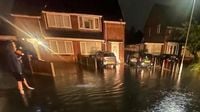After more than 20 hours of relentless rainfall battered north-west England over the weekend of September 20-21, 2025, communities across Greater Manchester, Lancashire, Cheshire, and Merseyside awoke to submerged streets, stranded vehicles, and a flurry of flood warnings. The downpours, which began on Saturday morning, prompted the Environment Agency to issue a total of 28 flood warnings across the region, with residents and local authorities scrambling to respond to rapidly rising water levels and mounting concerns for public safety.
In East Lancashire, the Environment Agency moved quickly as the rain intensified into Saturday evening, issuing warnings for areas adjacent to the River Darwen in Blackburn, including Ewood Park, Stancliffe Street, Griffin Mill, and River Mill. According to the Lancashire Telegraph, the flooding risk extended to locations near rivers in Accrington and Oswaldtwistle, affecting communities such as Dunnyshop, Baxenden, Lower Fold, and Little Moor End. The River Irwell in Bacup, Stubbylee Bridge, Stacksteads, and Brandwood Park also saw warnings, while Ribchester’s Higher Croft and properties near the River Ribble braced for possible inundation.
Blackburn Rovers’ football match at Ewood Park was abruptly abandoned with just 10 minutes left on the clock as the pitch became unplayable, with the home side leading Ipswich Town 1-0. It was a vivid reminder of how quickly the weather could disrupt even the most routine events. Stefan Laeger, flood duty manager at the Environment Agency, warned in a statement reported by the Lancashire Telegraph: “Widespread rainfall with isolated heavy bursts could lead to some significant river flooding across parts of the Northwest and some significant surface water flooding and minor river flooding across parts of the North of England and the Midlands from Saturday into Sunday morning.”
Communities further south were equally hard hit. In Greater Manchester, the Environment Agency issued warnings for Trafford, Stockport, south Manchester, Salford, Bury, and Bolton. Streets in Salford were left submerged, with vehicles stranded and local businesses forced to close their doors. Owen’s Kitchen and Bar in Hale reported that its kitchen was “completely submerged,” resulting in ruined stock and a temporary closure. “We’re very grateful to our guests for your patience, support and understanding and to our amazing staff who looked after guests and worked really hard to secure the venue,” the restaurant posted on social media, as reported by the Manchester Evening News.
Emergency services were stretched thin. In Swinton, Salford, firefighters rescued three men trapped inside a car at 4:30 am, as rising floodwaters made the road impassable. The BBC described scenes of abandoned vehicles in Altrincham and Salford, with sandbags delivered to some of the worst-hit residential streets. Raymond Wright, a resident of Penketh in Warrington, told BBC News the rising water levels had been “scary” for those living at the bottom of the slope, where “the drains aren’t coping with it at all.” He added, “We do get this quite regularly—as soon as we have a few hours of rain, you can guarantee we’ll have a lake down here.”
Warrington, in Cheshire, declared a major standby incident overnight as water levels threatened to breach flood thresholds in areas like the Sankey Brook at Causey Bridge, which came within 10cm of flooding just after 8:00 am on Sunday. The incident was later downgraded as levels subsided, but not before sandbags were distributed and some households were evacuated as a precaution. Warrington South MP Sarah Hall urged residents to “stay vigilant,” acknowledging how worrying flood alerts can be for families who have experienced them before.
By Sunday morning, the Environment Agency began to remove flood warnings as water levels dropped, but not before significant disruption had been felt across the region. Rail services between Bolton and Blackburn were suspended, with replacement buses running due to flooding, and similar disruptions were reported on routes between Manchester Piccadilly and Glossop, and Hadfield. Councillor Danny Fletcher, representing Ashton-in-Makerfield, thanked agencies for their coordinated response, noting “huge improvements in terms of organisation compared to New Year’s Day, led by the flood action groups across Wigan.”
Despite the improving outlook by midday Sunday, one flood alert remained in force for the Upper River Douglas catchment area in Wigan and Horwich. The Environment Agency warned that flooding of roads and low-lying land remained possible, though property flooding was not expected. “Areas most at risk include The River Douglas from Horwich Star Vale to Appley Bridge including Adlington, Blackrod, Wigan, Standish, and Gathurst,” the agency stated, advising the public to avoid walking, cycling, or driving through flood water and to steer clear of low-lying footpaths and bridges near local watercourses.
Some areas narrowly escaped more severe damage. The River Mersey at Northenden peaked at 1.85 meters by 2:00 am on Sunday—just below the 2.05-meter threshold at which homes would be at risk of flooding. Similarly, the River Irwell at Bury Ground saw its level rise from 0.34 meters on Saturday morning to 1.47 meters by 2:00 am Sunday, still below the warning threshold for property impact.
For business owners, the aftermath was all too real. EZ Bar and Cafe in Altrincham, another local business, was forced to turn away customers as water flooded the premises. The venue managed to reopen after a major clean-up, but the scars of the storm lingered. On the roads, Lumns Lane in Swinton was reported as “just passable,” while A49 Warrington Road in Ashton-in-Makerfield also suffered from flooding.
The Met Office had issued a severe yellow weather warning for heavy rain from 9:00 am on Saturday through to 6:00 am on Sunday, with the potential for homes and businesses to be flooded and damage to buildings. The warning proved prescient, as emergency services and council workers toiled through the night, clearing grids, removing debris, and operating flood basins where needed. Ben Hartley, a councillor in Trafford, urged residents to “only travel if absolutely necessary,” emphasizing that “lots of localised flooding on several roads around Trafford” made journeys hazardous.
As the skies cleared on Sunday and water levels receded, the region was left to count the cost and reflect on the lessons learned. The coordinated response by emergency services, councils, and flood action groups undoubtedly prevented more widespread devastation, but for many, the storm served as a stark reminder of the increasing frequency and intensity of extreme weather events. With the Environment Agency continuing to monitor river levels and urging the public to sign up for flood warnings, the communities of north-west England remain vigilant—ready to respond should the waters rise again.


